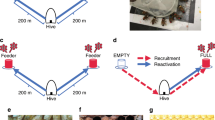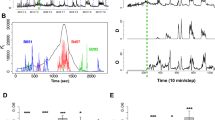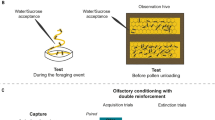Abstract
The honeybee dance language, in which foragers perform dances containing information about the distance and direction to food sources, is the quintessential example of symbolic communication in non-primates1,2. The dance language has been the subject of controversy3,4, and of extensive research into the mechanisms of acquiring1,5,6, decoding7,8 and evaluating9 the information in the dance. The dance language has been hypothesized, but not shown, to increase colony food collection1,9,10. Here we show that colonies with disoriented dances (lacking direction information) recruit less effectively to syrup feeders than do colonies with oriented dances. For colonies foraging at natural sources, the direction information sometimes increases food collected, but at other times it makes no difference. The food-location information in the dance is presumably important when food sources are hard to find, variable in richness and ephemeral. Recruitment based simply on arousal of foragers and communication of floral odour, as occurs in honeybees1, bumble bees11 and some stingless bees12, can be equally effective under other circumstances. Clarifying the condition-dependent payoffs of the dance language provides new insight into its function in honeybee ecology.
This is a preview of subscription content, access via your institution
Access options
Subscribe to this journal
Receive 51 print issues and online access
$199.00 per year
only $3.90 per issue
Buy this article
- Purchase on Springer Link
- Instant access to full article PDF
Prices may be subject to local taxes which are calculated during checkout


Similar content being viewed by others
References
von Frisch, K. The Dance Language and Orientation of Honeybees (Harvard Univ. Press, Cambridge, Massachusetts, 1967)
Dyer, F. C. The biology of the dance language. Annu. Rev. Entomol. 47, 917–949 (2002)
Wenner, A. M. & Wells, P. H. Anatomy of a Controversy 57–463 (Columbia Univ. Press, New York, 1990)
Gould, J. L. The dance-language controversy. Q. Rev. Biol. 51, 211–244 (1976)
Wehner, R. & Rossel, S. in Experimental Behavioral Ecology And Sociobiology; International Symp., Mainz, West Germany, Oct. 17–19, 1983 (eds Hölldobler, B. & Lindauer, M.) 11–53 (Sinauer, Sunderland, Massachusetts, 1985)
Esch, H. E. & Burns, J. E. Distance estimation by foraging honeybees. J. Exp. Biol. 199, 155–162 (1996)
Michelsen, A., Andersen, B. B., Storm, J., Kirchner, W. H. & Lindauer, M. How honeybees perceive communication dances, studied by means of a mechanical model. Behav. Ecol. Sociobiol. 30, 143–150 (1992)
Kirchner, W. H. Acoustical communication in honeybees. Apidologie 24, 297–307 (1993)
Seeley, T. D. The Wisdom of the Hive: The Social Physiology of Honey Bee Colonies 69–265 (Harvard Univ. Press, Cambridge, Massachusetts, 1995)
Visscher, P. K. & Seeley, T. D. Foraging strategy of honey bee colonies in a temperate deciduous forest. Ecology 63, 1790–1801 (1982)
Dornhaus, A. & Chittka, L. Evolutionary origins of bee dances. Nature 401, 38 (1999)
Lindauer, M. Communication Among Social Bees (Harvard Univ. Press, Cambridge, Massachusetts, 1971)
Dyer, F. C. Mechanisms of dance orientation in the Asian honey bee Apis florea. J. Comp. Physiol. A 157, 183–198 (1985)
Brines, M. L. & Gould, J. L. Bees have rules. Science 206, 571–573 (1979)
Kirchner, W. H. & Grasser, A. The significance of odor cues and dance language information for the food search behaviour of honeybees (Hymenoptera: Apidae). J. Insect Behav. 11, 169–178 (1998)
Visscher, P. K. Les Insectes Sociaux. 12th Congress of the International Union for Study of Social Insects (Université Paris Nord, Paris, 1994)
Batschelet, E. Circular Statistics in Biology (Academic, New York, 1981)
Waddington, K. D., Visscher, P. K., Herbert, T. J. & Richter, M. R. Comparisons of forager distributions from matched honey bee colonies in suburban environments. Behav. Ecol. Sociobiol. 35, 423–429 (1994)
Seeley, T. D. & Visscher, P. K. Survival of honeybees in cold climates: the critical timing of colony growth and reproduction. Ecol. Entomol. 10, 81–88 (1985)
Sherman, G. . The Role of Dance Language Cues in Recruitment and Food Collection in Honey Bee (Apis mellifera) Colonies. MS thesis, Univ. California Riverside (2002)
Acknowledgements
We are grateful to R. Vetter and D. Tanner for assistance at the feeders; R. Beaver for statistical advice; M. Zuk, J. Millar, R. Redak and T. Seeley for feedback; and the Department of Entomology and Academic Senate at UCR for financial support.
Author information
Authors and Affiliations
Corresponding author
Ethics declarations
Competing interests
The authors declare that they have no competing financial interests.
Rights and permissions
About this article
Cite this article
Sherman, G., Visscher, P. Honeybee colonies achieve fitness through dancing. Nature 419, 920–922 (2002). https://doi.org/10.1038/nature01127
Received:
Accepted:
Issue Date:
DOI: https://doi.org/10.1038/nature01127
This article is cited by
-
Decoding the dance parameters of eastern honeybee, Apis cerana
Apidologie (2023)
-
From dyads to collectives: a review of honeybee signalling
Behavioral Ecology and Sociobiology (2022)
-
Comparative psychophysics of Western honey bee (Apis mellifera) and stingless bee (Tetragonula carbonaria) colour purity and intensity perception
Journal of Comparative Physiology A (2022)
-
Multidisciplinary analysis of Italian Alpine wildflower honey reveals criticalities, diversity and value
Scientific Reports (2021)
-
Network-based diffusion analysis reveals context-specific dominance of dance communication in foraging honeybees
Nature Communications (2020)
Comments
By submitting a comment you agree to abide by our Terms and Community Guidelines. If you find something abusive or that does not comply with our terms or guidelines please flag it as inappropriate.



